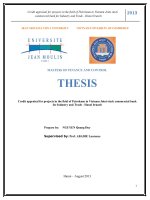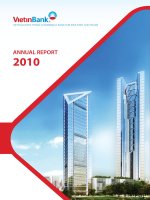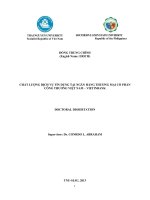Business strategy of viet nam joint stock commercial bank for industry and trade -thang long branch (vietinbank thang long) period 2012 - 2016
Bạn đang xem bản rút gọn của tài liệu. Xem và tải ngay bản đầy đủ của tài liệu tại đây (1.74 MB, 98 trang )
Strategic Management
CAPSTONE PROJECT REPORT
BUSINESS STRATEGY OF VIET NAM
JOINT STOCK COMMERCIAL BANK
FOR INDUSTRY AND TRADE -
THANG LONG BRANCH
(VIETINBANK THANG LONG)
PERIOD 2012 - 2016
Group 9
NGUYEN GIANG HOAI
VU VIET TUAN PHUONG
PHAM HAI YEN
NGUYEN CHIEN THANG
GAMBA M0110
HANOI 2012
Strategic Management
ACKNOWLEDGEMENT
To complete the course and fulfill graduation assignments with assigned
research, our group would like to thank most sincerely to the executive board, the
teachers of Global Advanced Master of Business Administration, Griggs University
- United States, Center for Educational Technology and Career Development (ETC)
Vietnam National University, Hanoi have created favorable conditions to help
us.We also thank Directors, department leaders of Vietnam Joint Stock Commercial
Bank For Industry and Trade (Vietinbank) - Nguyen Trai branch (now is Thang
Long Branch) for helping and providing necessary datas for us to do this subject.
However, due to time constraints so the subject has unavoidable shortcomings.
Therefore, the group is really eager to get the comments of the teachers to further
improve it and can apply effectively in the current economic conditions.
We hereby guarantee Group assignment is an independent work of us.
The datas, results stated in this assignment are honest and clear original.
THE AUTHORS
Strategic Management
TABLE OF CONTENTS
Acknowledgement
1
Table of contents
2
List of table
5
List of abbreviation
6
INTRODUCTION
7
1. Background, necessity and significance of the topic
7
2. Objective and scope of the study
10
3. Methodology of the topic
10
4. Structure of this topic
11
CHAPTER I : THEORETICAL BASIS IN BUILDING THE BUSINESS
STRATEGY OF THE COMPANY
12
1.1 BUSINESS STRATEGY OF THE COMPANY
12
1.1.1 The concept of business strategy
12
1.1.2 The role of business strategy
13
1.1.3 Business strategy of banking operations today
14
1.2 BUSINESS STRATEGY BUILDING AND CHOICE
14
1.2.1 Building process of business strategy
14
1.2.2 Research into business environment of the company
16
1.2.2.1 Macro environment
16
1.2.2.2 Micro environment
16
1.2.2.3 The external factor evaluation (EFE) matrix
17
1.2.2.4 Competition image matrix
17
1.2.2.5 The internal factor evaluation (IFE) matrix
18
1.2.2.6 SWOT matrix
18
1.2.3 Business strategy choice
20
1.2.3.1 Propose strategy
20
1.2.3.2 The best of strategy choice (QSPM)
21
Strategic Management
CHAPTER II : ANALYSIS OF THE BUSINESS SITUATION IN
VIETINBANK THANG LONG
23
2.1 BASIC INFORMATION ABOUT THE VIETINBANK
23
2.1.1 Establishment and development of Vietinbank
23
2.1.2 Establishment and development of Vietinbank Thang Long
25
2.1.3 Mission and Vision
26
2.2 SITUATION BUSINESS OF VIETINBANK THANG LONG 2009-2011
27
2.3 ANALYSIS OF BUSINESS STRATEGY VIETINBANK THANG LONG
31
2.3.1 Analysis of external environment
31
2.3.1.1 Macro environment
31
2.3.1.2 Industry and competition environment
41
2.3.2 Analysis of internal environment of Vietinbank Thang Long
50
2.3.2.1 Analysis human resource
50
2.3.2.2 Identify Strength
55
2.3.2.3 Weakness
56
2.3.3 Conclusion
58
CHAPTER III: BUILDING AND CHOOSING BUSINESS STRATEGY FOR
VIETINBANK THANGLONG UNTIL 2012
60
3.1 OBJECTIVE AND VISION UNTIL 2016.
60
3.1.1 Objectives to 2016
60
3.1.1.1 Strategic objectives
60
3.1.1.2 Particular objectives
61
3.1.2 Vision
63
3.2 SOLUTIONS AND SUGGESTIONS ABOUT BUSINESS STRATEGY OF
VIETINBANK THANG LONG
63
3.2.1 Building business strategy
64
3.2.1.1 Analysis follow to SWOT matrix
64
3.2.1.2 Analysis follow to SPACE matrix
65
Strategic Management
3.2.1.3 Analysis follow to QSPM matrix
67
3.2.2 Business strategy choice
69
3.2.2.1 Basic to choice
69
3.2.2.2 Best of business strategy determination
70
3.2.3 Solutions of implement the business strategy
71
3.2.3.1 Solutions of organization structure, business management process and
regulation completion
71
3.2.3.2 Solutions of human resource management
72
3.2.3.3 Solutions of improve financial capability
74
3.2.3.4 Solutions of operation network development
75
3.2.3.5 Solution of marketing strategy
76
3.3 PROPOSALS TO THE GOVERNMENT, STATE BANK AND
VIETINBANK
78
CONCLUSION
81
ANNEX 1: Financial report 2010
83
ANNEX 2: Financial report 2011
89
REFENRENCE
97
Strategic Management
LIST OF TABLE
Table 1-1
The stages in the strategy building process
Table 1-2
SWOT Matrix
Table 1-3
Space Matrix.
Table 1- 4
QSPM Matrix.
Table 2-1
Business result of Vietinbank Thang Long 2009 -2011
Table 2-2
GDP growth through the years
Diagram 2-3
Foreign direct investment
Diagram 2-4
Inflation indicator through the years
Table 2-5
Exchange
Table 2-6
Growth credit and money supply
Table 2-7
The competitors
Table 2-8
Matrix of factors outside of Vietinbank Thang Long
Table 2-9
Competition image matrix .
Table 2-10
The situation to mobilize funding from 2009-2011
Table 2-11
The situation according to the quality of loans outstanding in 2009-
2011
Table 2-12
Status of the loan outstanding from time to time in 2009-2011
Table 2-13
Situation of balance capital Forex trading in 2009-2011.
Table 2-14
Internal factor matrix of Vietinbank Thang Long
Table 3-1
SWOT Matrix
Table 3-2
SPACE Matrix
Table 3-3
QSPM matrix
Table 3-4
Priority strategy choice
Strategic Management
LIST OF ABBREVIATION
WTO
World trade Organization
WB
World Bank
AFTA
ASEAN Free Trade Area.
Vietinbank
Thang Long
Vietnam Joint Stock Commercial Bank For Industry and Trade
(Vietinbank) - Thang Long Branch
IFE
Internal factor evaluation Matrix
EFE
External factor evaluation Matrix
SPACE
The strategic position and Action Evaluation Matrix
QSPM
Quantitative strategic planning matrix
GDP
Gross domestic product
ROA
Return on assets
ROE
Return on equity
NHNN
State bank
ATM
Automated teller machine
CITAD
Electronic Payment Interbank
SWIFT
Society for Worldwide Interbank Financial Telecommunication
CAR
Capital adequacy ratio
FDI
Foreign direct investment
ICOR
Incremental Capital - Output Rate
Vietcombank
Viet Nam commercial trade joint stock bank
BIDV
Bank for investment and development Vietnam
Agribank
Vietnam Bank of Agriculture and Rural Development
Strategic Management
INTRODUCTION
1. Background, necessity and significance of the topic.
* Background:
WORLD ECONOMY OVERVIEW: We can say, public debt and Government
budget deficit is a hot topic during the past year, particularly in the euro zone. 2011
started with a series of negative developments surrounding the euro rescue. The
action by Moody's in lowering level of confidence in Greece and Spain has raised
concerns among investors; making borrowing costs of the weakest members in the
eurozone continuously increase. Riots in Greece are creating additional pressure on
the government, causing bond yields to rise to record. Across the Atlantic coast,
Standard & Poor's has moved the problem’s assessment of U.S. debt from stability
to negativity, while the process of political compromise between the parties in the
US federal government about cutting expenses took place very slowly. At the same
time, the earthquake and tsunami in Japan occurred in March pulled down the
financial markets in the world. Oil prices rose unexpectedly in April because of
concerns about declining supply by political instability in the Middle East and
North Africa. These complicated changes made the price of gold constantly set new
record levels in the period from July to September. International investors rushed
for seeking for financial secure shelter, especially Standard & Poor's downgraded
the credit grade of US from AAA to AA + in August. Notably, in 2011, China
overtook Japan to become the second largest economy in the world. In the context
of post-stimulus, US government also had to constantly raise operation rate to
prevent inflation due to the fears that the growth would become too hot.
According to the latest statistic of the OECD, world trade in the third quarter of this
year grew 6.8% over the same period in 2010, and the number of the whole year
will be hard to be better in the fourth quarter because of influence of a decrease in
demand and a slow growth of EU regions. Particularly, the trade of OECD countries
Strategic Management
increased by 6%, while the non - OECD countries grew by 8.2%. The fiscal
tightening will slow economic recovery in developed countries. According to IMF,
the world economy will increase about 3.8% in 2012, down from 3.9% in 2011 and
5.2% in 2010. The new forecast updated in December revised down from
forecast figures published in early January 2011. This slowdown is a consequence
of the financial turmoil and the fear of public debt risks spreading outside
the European economy. The austerity measures will replace the stimulus package
for 2010 -2011 and most developed countries have GDP below potential output in
2012. However, compared with developed countries, growth prospect of developing
economies were growing brighter because of the weakening of external demand is
expected to be offset by domestic demand thanks to flexible economic policies
of the Government. (Source: IMF; forecast data was published in 12/2011).
VIETNAM’S ECONOMY: Along with vicissitudes of the world economy,
Vietnam's economy went through 2011 in the context of high inflation pressure,
production and business activities of enterprises, especially small and medium
enterprises encountered many challenges from high interest rates while the
government implemented a fairly tight monetary policy and fiscal policy in the
spirit of Resolution No. 11/NQ-CP. GDP growth rate for the whole year reached
5.89%: in the first quarter GDP rate reached 5.57%, 5.68% in the second quarter, in
the third quarter increased to 6.07% and 6.2% in the fourth quarter. This increase is
lower than the growth rate of 6.78% in 2010 and lower than planned tasks (6%) but
in the context of the complicated world economy and domestic this growth rate is
still higher than some countries in the region such as Thailand, Malaysia. In 5.89%
increase in general, the agriculture, forestry and fishery contributed 0.66% to
the general increase of 4%, industry and construction contributed 2.32% with 5.53%
increase and service sector contributed 2.91% with 6.99% increase.
(Source: General Statistics Office).
Strategic Management
* Necessity:
Facing the opportunities and challenges of the world economy and domestic,
Vietinbank with continuous process of innovation and perfection achieved high-
performance business has become one of the leading commercial banks in Vietnam.
With a vision to 2016, VietinBank will became a Group of Finance
& Banking with diversified services, the best quality products based on scientific
application of modern technology, advanced management degree with 2 basic
axis is currency trading and financial investment activities. To achieve these
objectives towards this target, the role of building strategy, management and
implementation strategy is very important as follows: Potential finance, technical
solutions, technology exploitation, risk management, products and services
development, system optimization, product pricing and performance measurement
of products and services, administration management. In the integration process,
Thang Long is a dependent member of VietinBank and will have to increasingly
intense competition. To survive and develop, Vietinbank Thang Long needs to
analyze current business strategy, thereby building strategy and business
development to 2016. Stemming from the above needs, we choose the topic:
"Business strategy of VietinBankThang Long in the period from 2012 to 2016"
* Significance:
- Develop an overall direction for the bank during the period 2012-2016. This
direction has clear, wide spreading objectives in the bank to mobilize resources to
implement given objectives. This topic will help to clarify the theoretical basis of
the strategy through the external factor evaluation (EFE) Matrix, internal
SWOT matrix, SPACE matrix and competitive advantage matrix of Michael
Porter in the case of Vietinbank Thang Long.
- Identify strengths and weaknesses in the current business strategy of Vietinbank
Thang Long
- Build mission and vision of Vietinbank Thang Long to 2016
Strategic Management
- Propose solutions to improve the strategy, strategic management and
implementation of strategies of Vietinbank Thang Long to 2016 in the most
effective way.
2. Objective and scope of the study:
Objective of this topic is aimed at following issues:
- The outline of the theory of model strategy as a basis for strategic research of
VIETINBANK Thang Long.
- Analysis of the current strategy of Vietinbank Thang Long
- Analysis of internal and external environment affecting strategic management of
Vietinbank Thang Long.
- Propose business strategy for Vietinbank Thang Long until 2016, breakthrough
solutions in:
• Developing corporate culture
• Improving financial capacity
• Improving the quality of service
• Investing in development and expand market share.
3. Methodology of the study topic:
Rationale for the study of this subject is derived from the guidelines, policies
and practical orientation activities of banks in Vietnam, the theory of strategic
management course, marketing management, methodological science, etc with
information sources: Websites, Journal of the sector; the published reports. To
complete this topic, we have used methods as follows: (1) collecting primary
documents. In order to collect primary data, we used sampling techniques to select
a small part of the population under study; collection methods and expedited
processing of assessments of the leading experts in banking and finance sector;
observation method of customer behavior of Vietinbank Thang Long and method of
analysis secondary data that was analyzed, explained, discussed and
interoperated of the bank to gather data.
Strategic Management
4. Structure of this topic:
This topic includes: the introduction, the conclusion; besides there are three basis
chapters as follows:
Chapter I: Theoretical basis in building the business strategy of the company
Chapter II: Analysis of the business situation in Vietinbank Thang Long
Chapter III: Building and choosing business strategies of Vietinbank Thang Long to
2016
Strategic Management
CHAPTER I
THEORETICAL BASIS IN BUILDING THE BUSINESS STRATEGY
OF THE COMPANY
1.1 BUSINESS STRATEGY OF THE COMPANY:
1.1.1 The concept of business strategy :
According to Johnson and Scholes, strategies are defined as follows:
"Strategy is the direction and scope of an organisation over the long-term: which
achieves advantage for the organisation through its configuration
of resources within a challenging environment, to meet the needs of markets and to
fulfil stakeholder expectations”. According to Michael Porter (1996)
“Strategy is the creation of a harmony among the activities of a company. The
success of the strategy relies on good conduct of many things and combine them
together. The core of the strategy is "choose what not to do." Under this access, the
strategy is to create a competitive difference, find and implement
(what not to do). The nature of this strategy is to build (competitive advantage);
it exists only in unique activities. In other words: The strategy is to build a unique
position and to impact a group of different activities.
Strategic Management: is the process of identifying the strategic objectives of
organization building and planning policies to achieve the objectives and
distribute sources of it for the implementation to achieve objectives in the future.
Features of this strategy are to create "competitive advantage", find and gain
sustainable advantage for customers and products. Strategic missions are:
- Identify where is the way that organization wants to go.
- Determine how organization can go.
- Use what means and tools to get there.
In other words, strategy is a orientation and scope of an organization in a long term
(in the future) to gain competitive advantage for organizations through the
Strategic Management
mobilization and determination of its resources in the changing environment to be
able to get a specific goal, meet the market demand and satisfy expectations of
parties. Strategic management includes five tasks: Develop prospect of strategies
and mission; set goals and build strategies to achieve goals; Execute and manage
selected strategies; Performance Evaluation, supervise and repair through
each task if necessary. (According to the book on strategic management
of Statistical Publishing House, 2009). As a result, strategic management is
a continuous operation for establishing, maintaining the strategic
direction and business activities of an organization to resolve challenges.
1.1.2 Role of business strategy
This is a tool to share the vision of leadership for all levels of management in the
competent stakeholders.
It demonstrates the consistency & the concentration of lines of business of the
company to avoid wasting resources on core activities as a management tool in
assessing the feasibility / identify priority / allocation of resources for strategic
business activities.
This is a basis for building organizational structures to support reasonable business
activities, to be able to operate towards the strategic objectives set out.
As a platform to build a business plan in detail
In the context of market economy and the environment with increasingly fierce
competition, companies need to make better management strategies to be more
active, see opportunities and competitive advantages in the market. The strategy
will contribute to making business more responsive and dynamic shocks on the
market, free to make rational decisions and controlling their activities, make use of
opportunities and processing, troubleshoot risk, strengthen competition and help
businesses market share and maintain its position.
Strategic Management
As a result, the strategy could have an important role during the operation of the
organization; contribute to the success or failure of your business. Activity strategy
allows a company more dynamic reactive in shaping the future.
1.1.3 The business strategy of banking operations today:
The industry is operating distinctive business; the banking industry has a number of
prominent business strategies as follows:
- Strategies to strengthen market share: fortify our strength, improve image,
reputation of the Bank, resolve unsolved, improve product quality services to attract
customers to maintain and develop market distribution.
- Strategy to diversify products and services: diversification of products and
services in the network performance to satisfy the needs of the highest customer,
customer development.
- Strategy to expand distribution network: diversification and expansion of the
Bank's distribution channels, Extensive expansion of the area in order to provide
customers the most convenience when transactions, thereby attracting customers
and increase competitiveness.
- Strategic focus: Business focuses on all its resources to achieving the target
growth and high efficiency.
- Differentiation strategy: Construction plans based on available strengths, business
characteristics, in order to achieve the objectives.
1.2 BUSINESS STRATEGY BUILDING AND CHOICE
1.2.1. Building process of business strategy:
We can generalize periods and activities in the strategy building process
through the following table:
Strategic Management
Table 1-1: The stages in the strategy building process
Steps
Content
Step 1
Systemization of information
Step 2
Combining information to make the set of feasible business
strategy
Step 3
Use all information overview to choose a best strategy for
business
Setting strategy is process of setting up business tasks, realizing survey
research for internal working out long-term objectives and choosing between
alternative strategies. We can also call this phase strategic planning.
Step 1: Strategies by collecting data, combined with the intuition, the actual
analysis and selection of viable alternative strategies with a number of strategic
management techniques such as external factor evaluation (EFE) matrix and
internal factors (IFE) matrix.
Step 2: Using internal and external factor of the business to make a feasible
business strategy by using a matrix of tools such as: SWOT matrix, SPACE matrix.
Step 3: By using information in period 1, objective audit in period 2, we can choose
a business strategy through a number of key tools such as QSPM matrix
To ensure the highest effectiveness during operations, strategists forced to
make the decision that strategic choices will benefit the company most. Decisions in
the strategic period of forming organization will attach to the products, markets and
technologies in a long term. The competitive advantage in the long term specified in
the strategy. This is a very important period of strategic decisions, but will have
long-term or nasty or better effects for organization.
Strategic Management
1.2.2. Research into business environment of the company
1.2.2.1 Macro - Environment
This is one of the two elements of the external environment may affect the
implementation of business objectives. External environment is outside the business
that administrators do not control their effects, but they affect the operation of the
business. Micro-environment includes:
- Institutional-law (Political)
- Economics (Economics)
- Culture and Society (Sociocultural)
- Technology (Technological)
- Demographics (demographic)
These factors have a direct impact to the economic sector. Businesses based on
impact, to influence policy making, business activities accordingly.
Thus, the macro environment analysis helps to identify changes from the elements
of the external environment. Bank allows businesses to realize the opportunities and
challenges from the macro environment.
1.2.2.2 Micro-environment:
Micro-environment or industry environment is a variety of factors directly to the
Bank and its competitive actions, the competitive response of the Bank. The
business sector is influenced by the micro-environment of the industry, including:
- For the potential
- Competitors-current
- Client
- Supplier
- The financial-market alternative
- Analysis of environmental factors will enable micro enterprises to identify clearly
what are the business opportunities that can utilize and what are the challenges and
Strategic Management
risks that businesses face in which the forces of change will bring, through war, to
build adaptive capacity.
1.2.2.3 The external factor evaluation (EFE) Matrix:
EFE matrix is set sequentially as 5 steps:
* List of factors is decisive in the trades that business is business, including the
opportunities and challenges
* Reviews the level of importance of each factor score from 0.0 to 1.0 (level of
important ascendant) with a total score of factors equal to 1. This important level
based on sector business enterprises are activities.
* Grading from 1 to 4 for each element with a score expressing the level of response
of the business with that element. Point 4 is good response. Point 3 is the response
on average. Point 2 is the average response and point 1 is little response.
* Determine the total number of points for each factor (by area of get in step 1 and 2)
* Determine the total score of the importance of the business by the total number of
points obtained in step 3.
The highest point total is 4 and the lowest is 1. The average is 2.5 points. The higher
the score shows businesses react well to the elements outside.
1.2.2.4 Competition image matrix:
This matrix identifies the principal competitors of the business. This matrix is the
expansion of the EFE matrix with the level of importance of the factors, the
significance of each factor score and total score is important has the same meaning.
Matrix photos EFE matrix with other competitors in that: there are a number of
factors within the importance the decision also was put on to compare. Total score
evaluation of the competitors will be compared with the enterprise was selected as
the template.
Strategic Management
1.2.2.5 The internal factor evaluation (IFE) Matrix:
This is the environment within the enterprise system elements, including tangible
and intangible elements that exist in the operation of the business or organization
and influence directly to the process management strategy. Every business has
different internal environment. The analysis of internal business will allow
identification of the strengths (S) and weaknesses (W) of the business. Through
analysis we use the matrix element inside (IFE). Since then, the business strategy is
selected to maximize the strengths and overcoming weaknesses of enterprises.
The Setup matrix IFE includes 5 steps:
• Establish portfolio of the elements inside the role to decide.
• Assess the level of importance of each factor score from 0.0 to 1.0 (level of
important ascendant) with a total score of factor of 1. This important level based on
the importance of it for business; irrespective of this factor are the strengths or
weaknesses of enterprises.
• Grade from 1 to 4 for each element with a score expressing the internal
characteristics of the business for that element. Point 1 is the biggest weakness,
point 2 is the smallest weakness, point 3 is the smallest strengths, point 4 is the
largest strengths
• Determine the total score for each element (by number of scores in step 2 and step 3)
• Determine total score on the importance of the business (in total points in step 4).
The highest point total is 4 and the lowest is 1. The average is 2.5. Important score
lower than 2.5 shows weak internal business, points higher than 2.5 shows strong
business about internal.
1.2.2.6 SWOT Matrix:
Using SWOT matrix to assess in order to determine the strengths (S-Strength),
weaknesses (W - Weakness), opportunities (O-opportunites), challenge (T-Threats)
from the effects of the business environment for enterprises to devise strategies,
solutions to promote the strengths, overcome weaknesses, leverage opportunities,
Strategic Management
limiting and controlling the challenge. Through SWOT matrix can plan strategies:
strategic COMPARISON:
SO strategy: use the strengths within the enterprise in order to take
advantage of and exploit the opportunities derived from the external
environment
WO strategy: take advantage of the strategic opportunity from the
external environment to limit the weakness of enterprises.
WT strategy: strategy to overcome weaknesses in order to limit the threat
of enterprise's external environment.
ST strategy: strategy and leverage FROM the more advanced strength
inside of the business in order to exceed or reduce the impact from the
threat of outside environment.
Strategic analysis is largely based on SWOT model. This model is suitable for the
assessment of the current state of the company through the situation analysis
(Strengths and Weaknesses) inside and outside (Opportunities and Threats)
company. SWOT made filter information according to an order more
understandable and easy to handle.
Table 1-2: SWOT Matrix. (S- Strength), (W-Weakness), (O – opportunites), (T-
Threats)
SWOT Matrix
Strength (S)
Weakness (W)
Opportunites (O)
SO strategy: Use these
strengths to take advantage
of the opportunities
WO strategy: Overcome these
weaknesses by taking advantage
of the opportunities.
Threats (T)
ST strategy: Use these
strengths to avoid threats
WT strategy: a minimum of the
weaknesses and avoid the threat
Strategic Management
Perform a SWOT analysis for the competitive position of the enterprise, shall be
charged to:
Strengths: advantages of enterprise resources mainly and as needed
Weaknesses: must know his weaknesses to avoid and overcome. Consider the issue
on the basis of inside and outside. Get the stars competitor can do better themselves.
Opportunity: Must see clearly and make good use of all opportunities. Draw
lessons upon opportunities that do not take advantage of
Threats: aware of the obstacles that are taking place. Consider thoroughly the
technology changes what with business risk or not? There are weak points which
are threatened.
1.2.3 Business strategy choice
1.2.3.1 Propose Strategy:
Using matrix elements inside –outside IFE to determine the current location of the
business here is the use of key points of the EFE matrix reflects on the shaft and
matrix IFE on the bounce. The intersection between IFE and EFE matrix of
business will give us the current businesses are located and how to use the business
strategy for the future as "strategy development and construction" (penetration in
the market, product development etc) or use the "strategy of holding, maintain ";
"strategy of harvesting and omitted"
There are many methods and tools that support the stage reviews strategic options,
however this only mentions big assignments support tool selection process
efficiency strategy, which is the matrix as matrix SPACE
of which criteria matrix Space as tools to identify the determinants of the
Organization's strategic location.
Strategic Management
Table 1-3: Space Matrix.
These factors include: the Organization's financial strength (FS); The Organization's
competitive advantage (CA); the stability of the business environment (ES); Power
of attraction (IS).
1.2.3.2 The best of strategy choice (QSPM):
Strategy election is a derivative of the whole process of planning business strategy.
The makers of strategic management will base on the analysis from the input to
select the optimal deployment strategy into reality. Strategic analysis and selection
mainly the subjective decisions based on objective information, to determine the
progress of activities may choose to ask for them that the company can fulfill its
responsibilities and goals. There are many methods and tools that support the stage
FS
Caution strategy 6
5
4
3
2
1
Attack strategy
CA -6 -5 -4 -3 -2 -1
-1
-2
-3
-4
Defensive strategy -5
-6
ES
0 1 2 3 4 5 6 IS
Competition strategy
Strategic Management
reviews strategic options; however this only mentions big assignments support tool
selection process efficiency strategy, which is the SPACE matrix and QSPM matrix:
Table 1- 4: QSPM matrix
Standard
Trọng
số
Strategies
Strategy 1
Strategy 2
…
Strategy n
Audit
point
Rules
change
point
Audit
point
Rules
change
point
Audit
point
Rules
change
point
Internal factors
(10 factors)
External factors
(10 factors)
Total
xx
Xx
Xx
In summary, the company in business process must be always determining
the short - term and long-term objective for themselves. Business strategy is the
way and the steps by steps on the way to reach objective. In chapter I was referring
to is the essential task of the strategic overview and governance strategies is the
basis for building, options and implementation strategies. This is exactly the basis
of reasoning needed to research the status of Vietinbank Thang Long and
application of business strategy into business activities of Vietinbank Thang Long
in the future.
Strategic Management
CHAPTER II
ANALYSIS OF THE BUSINESS SITUATION IN
VIETINBANK THANG LONG
2.1 BASIC INFORMATION ABOUT THE VIETINBANK
2.1.1 Establishment and development of Vietinbank
Full name: VIETNAM JOINT - STOCK COMMERCIAL BANK FOR
INDUSTRY AND TRADE
Trademark: (international transaction name): VIETNAM BANK FOR
INDUSTRY AND TRADE VIETINBANK
* Logo:
* Address: 108 Tran Hung Dao street, Hoan Kiem district, Hanoi
* Tel: 84.4. 3942.1030 Fax: 84.4. 3942.1032
* Website:
* VietinBank was established in 1988 after being separated from State Bank of
Vietnam.
* Being one of the four largest State-owned commercial banks of Vietnam,
VietinBank’s total assets account for over 20 percent of the market share of the
whole Vietnamese banking system. VietinBank’s capital resources keep on
increasing over the years and have been substantially rising since 1996 with the
annual average growth of 20 percent, especially up 35 percent a year against that of
last year.
* VietinBank has developed an operations network comprising of 01 Transaction
Centers, 149 branches, 527 transaction offices, 166 savings offices, 02
Representative offices, 04 Subsidiaries, 03 administrative units and 1042 Automatic
Strategic Management
Telling Machines (ATMs). It has established correspondent relationship with 850
banks, financial institutions of 90 countries and territories all over the world.
* Being diversified with 04 independent accounting subsidiaries: VietinBank
Leasing Company, VietinBank Securities Company, Ltd., VietinBank Asset
Management Company, VietinBank Insurance Company and 03 non-profit making
units: VietinBank Information Technology Center, VietinBank Card Center and
VietinBank Training Center.
* Being the founder of the following Financial Credit Institutions:
- Saigon Bank for Commerce and Industry
- Indovina Bank (the first joint-venture bank in Vietnam)
- Vietnam International Leasing Company – VILC (the first financial leasing
company in Vietnam)
- Vietinbank Insurance Company Ltd.
* Being the official member of :
- Vietnam’s Banker Association
- Asian Banker’s Association
- Society for Worldwide Interbank Financial Telecommunications (SWIFT)
- Visa International Services Association
* Being the first bank in Vietnam to apply modern technology and e-commerce in
its banking operations.
Mission: Be the leading financial group in Vietnam with versatile operation,
providing products and services according to the international standards to increase
the value of life.
Vision: To become a leading modem and efficient financial group in both domestic
and international scopes.
Core values:
- Focus on customers.
- Be active, creative, professional, devoted, transparent and modern.









